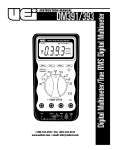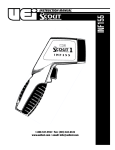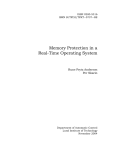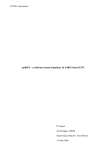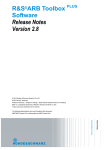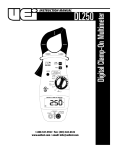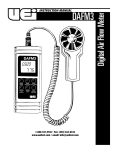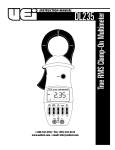Download UEi INF200 User's Manual
Transcript
INSTRUCTION MANUAL INF200 1-800-547-5740 • Fax: (503) 643-6322 www.ueitest.com • email: [email protected] Introduction International Symbols The INF 10 0 / 200 non-contact infrared thermometer provides a faster, easier way to take diagnostic temperature measurements. Monitor the t e m p e rature of transformers, circuit breaker panels, motors and bearings, supply and return registers, ducts, inlet/outlet steam lines, furnace flues and many other surfaces. Use the INF 200 when diagnosing temperature problems to save time and reduce the risk of burns and injuries. Features include • Switchable ˚F or ˚C readings • Quick and simple operation • Back-light • Long battery life • Temperature range of 0 to 788˚F (-20 to 420˚C) • On-board nine measurement memory • Barrel sight targeting • Laser targeting • User programmable alarm Controls and Indicators 12 11 8 9 6 Safety Notes Before using this instrument, read all safety information carefully. In this manual the word "WARNING" is used to indicate conditions or actions that may pose physical hazards to the user. The word "CAUTION" is used to indicate conditions or actions that may damage this instrument. WARNING! DO NOT point the laser toward the eyes or face of a person or animal. Laser light can cause eye injury, if the beam makes direct eye contact. Reflective laser light can also cause damage, if a mirror or a glass-like surface reflects the beam directly into the eye. Laser’s potential to cause damage is retained for hundreds of feet. Use caution. CAUTION! This equipment is intended for use be industry professionals who know their professional environments. Temperature measurements are often taken in potentially hazardous ares. Know and use the safety standards prescribed by your profession. 4 5 7 1 2 3 10 1. Fahrenheit / Centigrade select push-button, and mode down / decrease push-button. 2. Backlight push-button, and up / increase selector. 3. Temperature display mode select, memory recall and programming select (INF200) push-button. Validate Measurements The accuracy and validity of measurements taken with this device depends on various criteria. One of the most critical criteria to consider is emissivity (a more detailed explanation is provided in the validation section of this manual). Before using this instrument to determine if an area is safe to touch, or enter, verify your readings are reasonably accurate by using comparisons with already known measurements. 4. Temperature display mode indicator. Laser Splash: 9. E m i s s i v i tyannunciator. Indicates the use of laser equipment and the category of laser used. 10. Laser targeting on / off push-button. 5. Temperature measurement. 6. Fahrenheit / Centigrade scale indicator. 7. Low battery annunciator. 8. M e m o ry location annunciator. 11. Laser on annunciator. 12. Alarm mode indicator. INF200-MAN P. 1 Operating Instructions Taking Measurement Samples To take temperature measurements, point the instrument at the surface to be measured and pull the trigger. A tube has been incorporated along the top of the barrel to aid the user in spotting the surface area to be measured (target). Although this simple explanation works well in most cases, there are other factors that may impact the measurement accuracy. Consider there influences before using the data you obtain with your infrared thermometer. • The target must completely fill the spot diameter seen by the infrared sensor, otherwise the temperature displayed will be influenced by the surface surrounding the target. The ratio of the distance from the end of the barrel to the size of the spot being measured is 8:1. For example, using the INF200, an object that is 6” in diameter can be accurately measured from 4’ away. When using the gun to find hot-spots, accuracy of the reading is not as important as keeping the gun at the same distance from the target for each sample measurement. If you are looking for hot-spots on electrical panels, for instance, you could take the readings from 6’ away each time, even though you may only be filling half the spot diameter. The critical information in this process would be any significantly higher temperatures • Emissivity of an object will also affect accuracy. See the “Validation” section for details • This instrument is sensitive to electromagnetic interference (EMI), such as that generated by spark plug wires, radio transmitters and welders. Do not use this instrument in close proximity to equipment that may produce such interference • The instrument must be used within the ambient temperature range specified in the specification table Each time the trigger is pulled your INF200 monitors four different readings, regardless of the selected mode. They are: • • • • The highest temperature measured The lowest temperature measured The average temperature (time weighted) The Net difference between the light and low temperature “DT” These four measurements go into the first memory location for future recall, when the trigger is released. See “Recalling memory points” for more details. While the trigger is pulled, a temperature sample is taken at a minimum of once every 1/2 second (500 milliseconds). The four parameters mentioned above are updated at the same rate. Selecting Fahrenheit or Centigrade Scales Select the scale you prefer to use (˚F or ˚C) by pressing the (“˚F/˚C▼”) push-button while the trigger is pulled. INF200-MAN Backlight Operation To toggle the backlight on or off, press the push-button with the backlight “ “ symbol while the trigger is pulled. Once the backlight has been turned on, it will come on each time the trigger is pulled until it is toggled off. Please note that this feature significantly reduces the battery’s life. Measurement Modes This instrument allows you to select from one of five display modes. You can cycle through the modes in this order: • • • • • Real-time temperature measurements Maximum temperature measured (MAX mode) Minimum temperature measured (MIN mode) Temperature difference between MAX and MIN (∆T mode) Calculated (time weighted) average temperature (AVG mode) The last mode selected will remain selected the next time you pull the trigger. Real-time Temperature Measurement Mode This display mode shows the actual temperature of surfaces measured. This value is updated at least once ever 1/2 second. When the instrument is powered up for the first time, this mode is pre-set. Maximum Temperature (MAX) Mode To enter the “MAX” display mode, pull the trigger, and press and release the “MODE” push-button repeatedly until you see the word “MAX” displayed on the LCD. In the “MAX” mode the highest temperature measurement taken, during the current trigger pull, is displayed on the LCD. The temperature reading will update each time a higher temperature is measured. Minimum Temperature (MIN) Mode To enter the “MIN” display mode, pull the trigger, and press and release the “MODE” push-button repeatedly until you see the word “MIN” displayed on the LCD. In the “MIN” mode, the lowest temperature measurement taken, during the current trigger pull, is displayed on the LCD. The temperature reading will update each time a new lower t e m p e rature is measured. Average (AVG) Mode To select the “AVG” display mode, pull the trigger and press and release the “MODE” push-button repeatedly until “AVG” is displayed on the LCD. The term “time weighted” in reference to the averaging mode means all temperature measurements taken, from the time the trigger was first pulled, are averaged while taking measurements in this mode. If you were to walk along a wall for one minute taking readings that were generally 72 degrees, then walk by a spot for 1/2 second that was 20 degrees, no significant change in average temperature would be displayed. Temperature Differential (∆T) Mode To select the temperature differential display mode “∆T”, pull the trigger and press and release the “MODE” push-button repeatedly until “∆T” is displayed on the LCD. This display mode is used to determine the net temperature difference between two surfaces. This is particularly valuable when calculating net heating or cooling, since ambient temperature is effectively removed from the equation. P. 2 Validation NOTE: Always validate your instrument’s accuracy each time it is put into service. The term validation, as we use it here, is the method used to verify the measurement you are taking is accurate. Emissivity is a value, referring to the surface you are targeting, that relates to that surface’s ability to “emit” versus “reflect” heat energy. This value is a ratio of emitted heat energy to the total heat energy available (example, .95 to 1). Because the ratio is always referenced to a total available value of “1”, only the emitted heat value, typically between .30 for surfaces that reflect most of the available heat energy, to a high of around .98 for surfaces that emit nearly all of their heat energy. Some shiny, bright, polished or smooth surfaces reflect heat energy, and therefore, don’t have high emissivity ratings. Generally these surfaces are not recommended as targets for non-contact thermometers. They ca n , h owever, be prepared for non-contact measurement. Compensating for e m i s s i v i tyof an object is part of the validating procedure. For frequently repeated processes that warrant the use of a non-contact thermometer, take the time to perform one of the following prepara t o ryprocedures: • Pre-validate Accuracy: Most non-metallic surfaces have a natural emissivity value of about .95 (this instrument’s factory default), and need no additional preparation for measurement. To validate, take sample temperature readings from a surface in a controlled environment and compare them to the known temperature. For example, measure an empty cardboard box that has been sitting in a room for at least ten minutes, and compare those readings to the known room temperature. If a controlled environment is impractical, use contact temperature measuring devices such as UEi’s DT series thermometers or any one of the broad line of temperature measurement products, used in conjunction with one of UEi’s ATT series contact thermometer probes. For a quick validation, compare the reading of a prepared test area (see the next section ) to an unprepared area. If there is no difference, there's no need for additional preparation. • Physically Prepare Surfaces For Consistent Readings: Some objects, such as lead and certain other alloys have low e m i s s i v i tyratings. When temperature extremes and environmental conditions allow, the surface of such material can be modified to change the emissivity value to the conventional .95. To prepare these surfaces to provide an accurate reading using a non-contact thermometer, pre-treat (to emit energy) the surface with flat colored paint, masking tape, or some similar rough, dark, dull or porous coating that has an inherently high emissivity value. Make sure these surfaces won’t experience extreme environments that may burn, weather or otherwise degrade the surface preparation. Be sure not to harm the surface of the object you are preparing for non-contact measurement. Often materials are designed to be reflective to control heat build-up. Emissive surfaces may cause excessive heat energy to be retained, even in a small area, which may eventually damage the equipment or impair operation. Recalling Memory Points With each pull of the trigger, four values are recorded in memory. • • • • The highest temperature measured The lowest temperature measured The average temperature (time weighted) The value last displayed before releasing the trigger A total of nine sets of these four values, representing nine trigger pulls, are available for recall. To review recorded values, start with the instrument off, (trigger released and nothing visible on the LCD), then press and release the “MODE” push-button. The number “1” will appear on the display, indicating the latest of the nine sets of values recorded in memory. You may now either cycle through each of the four values recorded during the last trigger pull, or go to one of the four values, then select the number of the trigger pull you wish to review. For example, to select the high temperature measured three trigger pulls ago, you may either: 1. Press the “MODE” push-button once. The number “1” and a value appears. 2. Press the “ /▲“ push-button twice. The number “3” and a value appears. 3. Press the “MODE” push-button once again. The word “MAX” appears in the lower left of the LCD, along with the highest temperature recorded three trigger pulls prior. OR: 1. Press the “MODE” push-button once. The number “1” and a value appears. 2. Press the “MODE” push-button once again. The word “MAX” appears in the lower left of the LCD, along with the highest temperature recorded during the last trigger pull. 3. Press the “ /▲“ push-button twice. The number “3” and a value of the highest temperature recorded from three trigger pulls ago appear. To maneuver up and down through recorded values, press the appropriate “˚F/˚C/▼” or “ /▲“ push-button to view the different readings on the LCD. Audible Alarms The INF200 will sound an audible alarm at both an upper and a lower temperature limit, whig you set. To adjust the alarm, start with instrument’s power turned off. Press and hold the “MODE” push-button until you hear an audible beep. Either “MAX” or “MIN” will be displayed on the LCD, along with a value to the right. Do not pull the trigger. Select the mode “MAX” or “MIN” you want the instrument to provide the alarm for by pressing either the “˚F/˚C/▼” push-button to select the low temperature alarm or the “ /▲“ push-button to select the high temperature alarm. Once the instrument indicates the alarm mode you want to set, press the “MODE” push-button again. Once the surface has been prepared, validate your readings as previously indicated. INF200-MAN P. 3 You’re now ready to adjust the alarm’s threshold value, displayed on the LCD. To decrease the value press the “˚F/˚C/▼” push-button. To increase this value, press the “ /▲“ push-button. To lock this value in, once again, press the “MODE” push-button again. The alarm settings (whatever is displayed at the time) are instantly saved if, at any time during the alarm setting process, the instrument either shuts off after five seconds of inactivity or the trigger is pulled. Emissivity Adjustment When a process calls for repeated measurements of like materials, such as evaluating a plastic’s solidity at a processing plant, the best method of attaining quick, reliable temperature readings is to adjust the emissivity setting of your INF200. To set emissivity you must pass through the alarm setting function. As described earlier, press and hold the “MODE” push-button until an audible tone is heard, and the LCD displays the alarm adjustment function. Do not pull the trigger, or let the instrument time-out and turn off. Press the “MODE” push-button once more to display the current emissivity value. To decrease the value press the “˚F/˚C/▼” push-button. To increase the value, press the “ /▲“ push-button. To exit and save the newly set value, press the “MODE” push-button again, let the instrument time-out in five seconds, or pull the trigger. The value last entered for emissivity will become the instrument’s default next time it is used. If the instrument will be used on various surfaces or by various people for different applications, it is a good practice to reset the emissivity value to .95 before returning it to storage. Knowing the emissivity value your instrument is set at may prevent the collection of erroneous data that could result in unnecessary, time consuming and costly process step adjustments. Laser Targeting CAUTION! DO NOT point the laser at the eyes or face of any human or animal. Eye damage may result from direct exposure to laser light. Reflective laser light, from mirrors, glass, etc. can also cause eye damage. Laser is effective for hundreds of feet. Be aware of what or who is in your line of sight. Keep this device away from children, except under direct adult supervision. To toggle the laser targeting feature on, or off depress the “LASER” push-button while pulling the trigger. You can engage the laser function from any of the five measurement modes (see section four to review the measurement modes). Once selected, the laser light is activated each time the trigger is pulled until it has been toggled off. NOTE: The laser remains on for approximately 1/2 second after the trigger is released. Maintenance Service WARNING! Repair and service of this instrument is to be performed by qualified personnel only. Improper repair or service could result in physical degradation of the meter. This could alter the protection from electrical shock and personal injury this meter provides to the operator. Perform only those maintenance tasks that you are qualified to do. These guidelines will help you attain long and reliable service from your meter: 1. Keep your meter dry. If it gets wet, wipe it dry immediately. 2. Whenever pra c t i cal, keep the instrument away from dust and dirt, which can cause premature wear and collect on internal components. 3. Although your instrument is built to withstand the rigors of daily use, it can be damaged by severe impacts. Use reasonable caution when using and storing the meter. NOTE: When servicing the instrument, use only the replacement parts specified. Battery: 9V, NEDA 1604 or IEC 6LR 61 Cleaning and Decontamination Periodically clean your instrument's case using a damp cloth. DO NOT use abrasives, cleaning solvents or strong detergents, as they may damage the finish or affect the reliability of the structural components. When the infrared lens becomes contaminated, try removing any debris with low pressure compressed air, such as that used on computer keyboards. If the contaminant can not be removed with air, use a residue free glass cleaning solution on the end of a soft cotton swab. The swab should be slightly damp, and very light pressure should be applied to the lens. Battery Replacement Always use a fresh replacement battery of the specified size and ty p e . Immediately remove the old or weak battery from the meter and dispose of it in accordance with your local disposal regulations. Old or defective batteries can leak chemicals that corrode electronic circuits. To remove and replace the battery, turn the instrument upside down; and slide the battery access panel (a plate at the bottom of the pistol grip) f o rward with your thumb. Carefully remove the battery from the battery clip. A small flat-blade screw driver may be used to gently pry the clips away from the battery posts. When placing a new battery in the clip, make sure the clip fits tight around both posts of the battery. Some batteries are slightly larger or smaller than others. If necessary, compress the metal prongs on the clip to get a tight fit on the new battery. Ensure the small red and black wires are not in a position to be pinched or cut, as the battery is replaced in its slot. Replace the battery access cover. INF200-MAN P. 4 Specifications Temperature range Accuracy Repeatability Response time Special response MIN/MAX/▲T/AVG temperature Recall last reading HI or LO audible / visible alarm LCD backlight Laser (class 2 output) Emissivity Temperature display Display resolution Ambient operating range Relative humidity Storage temperature Power Battery life (Alkaline) Dimensions Weight Accessories Distance spot ratio 0 to 788˚F (-20 to 420˚C) ±2% of rdg. or ±3˚F (±2˚C), whichever is greater @ 73 ±9˚F (23 ±5˚C) ambient operating temperature and a known blackbody emissivity ±1% of rdg. or ±2˚F (±1˚C) whichever is greater 500 m sec. (95% response) 7-18 microns nominal thermopile detector X X X X X .30 - 1.00 digitally adjustable ˚F or ˚C (selectable) 3 digit LCD 1˚F or 1˚C in all modes 32 to 120˚F (0 to 50˚C) 10 - 95% RH noncodensing @ up to 85˚F (30˚C) -13 to 158˚F (-25 to 70˚C) without battery 9V Alkaline battery All models 50 hrs. (backlight not used)* Enhanced laser sighting model 16 hrs. Laser used 50%, backlight used 50%** 5.4” x 1.6” x 7.7” (137 mm x 41 mm x 196 mm) 9.5 oz. (270 gm) Water resistant hard case and manual 8 to 1 *Laser is offset 1 -2 cm (0.5”) above center of target spot. **Battery life will vary based on backlight and laser storage. Troubleshooting No display or erratic display: check the battery for proper voltage and tight contact at the battery clip. Ensure the unit is at the specified operating temperature. Constant or spurious over-load (OL) display: check battery voltage. Check for electromagnetic interference (EMI). To check for EMI, move the unit to an open area, away from high voltage and radio or radar transmitting sources. Errornous temperature readings: inspect the infrared lens for blockage or contamination. Follow cleaning instructions. Check battery for proper voltage and tight fit in the battery clip. INF200-MAN Emissivity Values Typical Emissivity Values - Metals Surface Iron and Steel Cast iron (polished) Cast iron (turned at 100˚C) Cast iron (turned at 1000˚C) Steel (ground sheet) Mild steel Steel plate (oxidized) Iron plate (rusted) Cast iron (rough) rusted Rough ingot iron Molten cast iron Molten mild steel Stainless steel (polished) Stainless steel (various) Aluminum Polished aluminum Aluminum (heavily oxidized) Aluminum oxide at 260˚C Aluminum oxide at 800˚C Aluminum alloys, various Brass Brass (polished) Brass (roughened surface) Brass (oxidized) Copper Copper (polished) Copper plate (oxidized) Molten copper Lead Lead (pure) Lead (oxidized at 25˚C) Lead (oxidized, heated to 200˚C) Nickel and its alloys Nickel (pure) Nickel plate (oxidized) Nichrome Nichrome (oxidized) Zinc (oxidized) Galvanized iron Tin-plated steel Gold (polished) Silver (polished) Chromium (polished) Emissivity 0.2 0.45 0.6 to 0.7 0.6 0.3 to 0.5 0.9 0.7 to 0.85 0.95 0.9 0.3 0.3 to 0.4 0.1 0.2 to 0.6 0.1* 0.25 0.6 0.3 0.1 to 0.25 0.1* 0.2 0.6 0.1* 0.8 0.15 0.1* 0.3 0.6 0.1* 0.4 to 0.5 0.7 0.95 0.1* 0.3 0.1* 0.1* 0.1* 0.1* *Emissivity various with purity. P. 5 Emissivity Values Typical Emissivity Values - Non-Metals Surface Emissivity Refractory & Building Materials Red brick 0.75 to 0.9 Fire clay 0.75 Asbestos 0.95 Concrete 0.7 Marble 0.9 Carborundum 0.85 Plaster 0.9 Alumina (fine grain) 0.25 Alumina (coarse grain) 0.45 Silica (fine grain) 0.4 Silica (coarse grain) 0.55 Zirconium silicate up to 500˚C 0.85 Zirconium silicate at 850˚C 0.6 Quartz (rough) 0.9 Carbon (graphite) 0.75 Carbon (soot) 0.95 Timber (various) 0.8 to 0.9 Miscellaneous Enamel (any color) 0.9 Oil paint (any color) 0.95 Lacquer 0.9 Matte black paint 0.95 to 0.98 Aluminum lacquer 0.5 Water 0.98 Rubber (smooth) 0.9 Rubber (rough) 0.98 Plastics (various, solid) 0.8 to 0.95 Plastic films (.05 mm thick) 0.5 to 0.95 Polythene film (.03 mm thick) 0.2 to 0.3 Paper and cardboard 0.9 Silicone polish (.03 mm thick) 0.7 *Emissivity various with purity. INF200-MAN P. 6 INF200 Infrared Thermometer Limited Warranty The INF 200 is warranted to be free from defects in materials and workmanship for a period of one year from the date of purchase. If within the warra n ty period your instrument should become inoperative from such defects, the unit will be repaired or replaced at UEi’s option. This warra n ty covers normal use and does not cover damage which occurs in shipment or failure which results from alteration, tampering, accident, misuse, abuse, neglect or improper maintenance. Batteries and consequential damage resulting from failed batteries are not covered by warra n ty. Any implied warranties, including but not limited to implied warranties of merchantability and fitness for a particular purpose, are limited to the express warranty. UEi shall not be liable for loss of use of the instrument or other incidental or consequential damages, expenses, or economic loss, or for any claim or claims for such damage, expenses or economic loss. A purchase receipt or other proof of original purchase date will be required before warra n ty repairs will be rendered. Instruments out of warra n ty will be repaired (when repairable) for a service charge. Return the unit postage paid and insured to: 1-800-547-5740 • FAX: (503) 643-6322 www.ueitest.com • Email: [email protected] This warranty gives you specific legal rights. You may also have other rights which vary from state to state. PLEASE RECYCLE Copyright © 2007 UEi INF200-MAN 1/07








